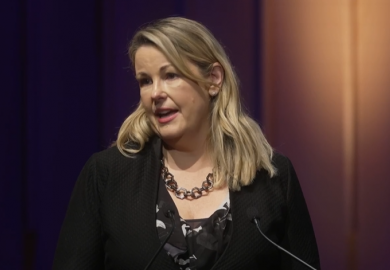Seven-figure salaries are becoming the norm for Australia’s lavishly paid vice-chancellors, a Times Higher Education analysis has revealed.
The average remuneration package for bosses of Australia’s 37 public universities reached A$982,900 (£543,800) last year, with 16 leaders pocketing more than A$1 million each – up from 13 in 2017 and 11 in 2016.
Vice-chancellors’ earnings rose an average of A$47,400 or 5.1 per cent in 2018. This compares with a mean salary increase of 2.3 per cent for the country’s workers, suggesting that the pay gap between university bosses and their staff widened last year.
Australian vice-chancellors also widened the gap over their British counterparts, who typically earned about 55 per cent as much, down from 56 per cent in 2017. English university chiefs’ remuneration averaged about £299,000 in the 2017-18 academic year, up from £294,000 in 2016-17.
Higher education consultant Justin Bokor said that the pay disparity between UK and Australian vice-chancellors negated one of the main rationales for the high antipodean remuneration. “The argument is that it’s an international marketplace and you need to pay competitive salaries,” Mr Bokor said.
“There is a fair bit of flow between the UK and Australia, so I’m not sure that argument holds.” About half of Australia’s 22 overseas-born vice-chancellors come from the UK.
But Mr Bokor said the fuss over university bosses’ pay was a “storm in a teacup”. Australian vice-chancellors typically earned several hundred thousand dollars more than the heads of large government departments, which were not subject to the same competitive pressures as universities, but considerably less than the chief executives of stock market-listed companies, which are purely commercial organisations.
The best paid Australian university boss last year was departing University of Melbourne vice-chancellor Glyn Davis, whose valedictory package of A$1.58 million was A$285,000 higher than his 2017 earnings. A spokeswoman said the figure included a university residence which was also used for official functions.
Retiring vice-chancellors can pocket extra entitlements on their departure, with the University of Newcastle’s Caroline McMillen and Griffith University’s Ian O’Connor – who likewise finished up in 2018 – also enjoying pay rises.
Three vice-chancellors’ packages declined in 2018. However, 20 saw their remuneration rise by over A$30,000, with 11 of them pocketing more than A$50,000 extra. Five attracted pay increases of A$100,000 or more.
If the earnings of those who did not serve the full year were recalculated on a pro rata basis, 18 vice-chancellors earned more than A$1 million last year. And even allowing for the A$285,000 paid to Peter Sherlock of the University of Divinity, a niche private institution that reports its accounts in a similar fashion to the public universities, the average university chief still earned around A$965,000.
Grattan Institute analyst Andrew Norton said that the cost of vice-chancellors’ remuneration was not “massive in the grand scheme of university finances”. But universities kicked “own goals” with chief executive salaries that caused resentment and disrupted the collegial atmosphere.
“So many in the university are employed on a casual or fixed-term basis,” he said. “You’ve got this very wide discrepancy between low-paid insecure people and very highly paid people up the top.”
john.ross@timeshighereducation.com
Australian vice-chancellors’ remuneration, 2018
| University | Vice-chancellor | Earnings, 2018 (A$) |
Earnings, 2017 (A$) |
Change (%) |
| University of Melbourne | Glyn Davis* | $1,582,500 | $1,297,500 | 22 |
| University of Sydney | Michael Spence | $1,522,500 | $1,477,500*** | 3 |
| Australian Catholic University | Greg Craven | $1,325,000 | $1,305,000 | 1.5 |
| UNSW Sydney | Ian Jacobs | $1,292,500 | $1,247,500 | 3.6 |
| University of Queensland | Peter Høj | $1,192,500 | $1,157,000 | 3.1 |
| Flinders University | Colin Stirling | $1,175,000 | $1,075,000 | 9.3 |
| Deakin University | Jane den Hollander | $1,105,000 | $1,105,000*** | 0 |
| RMIT University | Martin Bean | $1,105,000 | $1,065,000 | 3.8 |
| Monash University | Margaret Gardner | $1,105,000 | $995,000 | 11.1 |
| University of South Australia | David Lloyd | $1,095,000 | $1,035,000 | 5.8 |
| University of Western Australia | Dawn Freshwater | $1,095,000 | $1,015,000 | 7.9 |
| Griffith University | Ian O’Connor* | $1,067,500 | $1,022,500 | 4.4 |
| James Cook University | Sandra Harding | $1,057,500 | $982,500 | 7.6 |
| University of Technology Sydney | Attila Brungs | $1,055,000 | $1,035,000 | 1.9 |
| University of Adelaide | Peter Rathjen | $1,052,500 | $722,500 | NDC |
| University of Newcastle | Caroline McMillen* | $1,039,000** | $875,000 | 18.7 |
| University of Tasmania | Rufus Black | $1,034,200** | $982,500 | NDC |
| Macquarie University | Bruce Dowton | $1,015,000 | $985,000 | 3 |
| Swinburne University of Technology | Linda Kristjansen | $975,000 | $955,000 | 2.1 |
| La Trobe University | John Dewar | $975,000 | $935,000*** | 4.3 |
| Curtin University | Deborah Terry | $975,000 | $905,000 | 7.7 |
| University of Wollongong | Paul Wellings | $935,000 | $905,000 | 3.3 |
| Murdoch University | Eeva Leinonen | $935,000 | $755,000 | 23.8 |
| Western Sydney University | Barney Glover | $904,181 | $904,181 | 0 |
| Queensland University of Technology | Margaret Sheil | $898,400** | $1,265,000 | NDC |
| Edith Cowan University | Stephen Chapman | $825,000 | $845,000 | -2.4 |
| Southern Cross University | Adam Shoemaker | $817,500 | $757,500 | 7.9 |
| University of Canberra | Deep Saini | $805,000 | $805,000 | 0 |
| University of the Sunshine Coast | Greg Hill | $785,000 | $745,000 | 5.4 |
| Charles Sturt University | Andy Vann | $768,781 | $757,791 | 1.5 |
| Federation University Australia | Helen Bartlett | $755,000 | $495,000 | NDC |
| University of New England | Annabelle Duncan | $735,000 | $735,000 | 0 |
| Victoria University | Peter Dawkins | $715,000 | $775,000 | -7.7 |
| Central Queensland University | Scott Bowman* | $697,500 | $832,500 | -16.2 |
| Australian National University | Brian Schmidt | $675,100**** | $662,500 | 1.9 |
| University of Southern Queensland | Geraldine Mackenzie | $652,500 | $577,500 | 13 |
| Charles Darwin University | Simon Maddocks | $622,500 | $622,500 | 0 |
| University of Divinity | Peter Sherlock | $285,000 | $265,000 | 7.5 |
Source: Universities’ 2018 annual reports. Note: In most cases, stated figure is at mid-point of A$10,000 or A$15,000 remuneration range quoted in annual report. NDC = not directly comparable.
* vice-chancellor resigned during 2018.
** vice-chancellor not in office full year; 2018 remuneration estimated on a pro rata basis.
*** 2017 figure revised since THE’s analysis last year due to methodological changes in calculating remuneration.
**** estimated figure. THE understands this vice-chancellor’s 2018 remuneration rose roughly in line with consumer price index.
Register to continue
Why register?
- Registration is free and only takes a moment
- Once registered, you can read 3 articles a month
- Sign up for our newsletter
Subscribe
Or subscribe for unlimited access to:
- Unlimited access to news, views, insights & reviews
- Digital editions
- Digital access to THE’s university and college rankings analysis
Already registered or a current subscriber?








